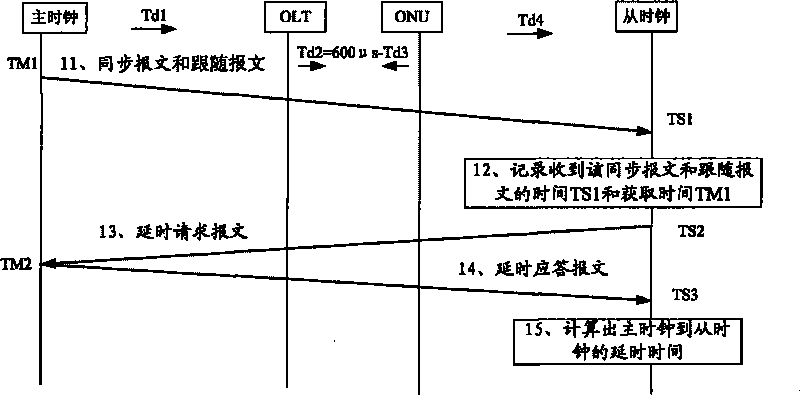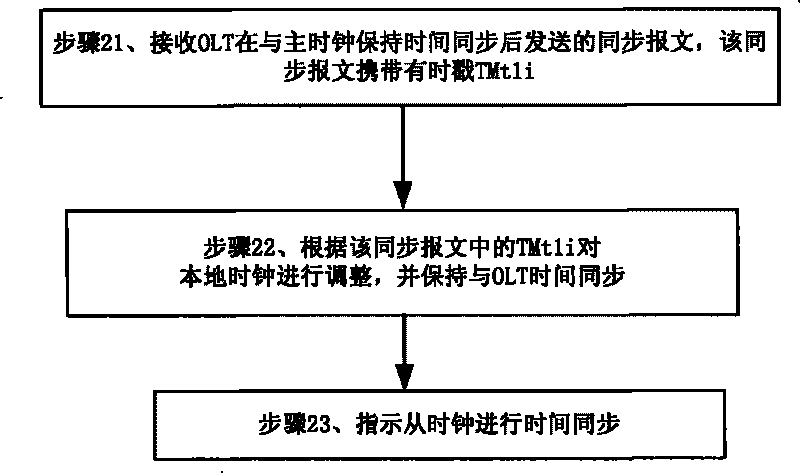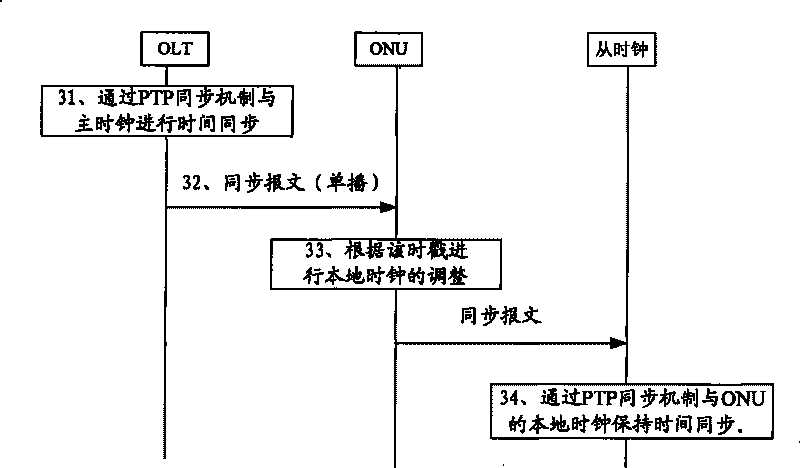Method and device for time synchronization in passive optical network and passive optical network
A passive optical network, time synchronization technology, applied in the field of network communication, can solve the problems of inaccurate delay, asynchronous time between slave clock and master clock, etc.
- Summary
- Abstract
- Description
- Claims
- Application Information
AI Technical Summary
Problems solved by technology
Method used
Image
Examples
Embodiment 1
[0073] Embodiment 1: Embodiment 1 provides a method for time synchronization in a passive optical network. The technical scenario of this embodiment is that the passive optical network of this embodiment is GPON. The method is as follows figure 2 shown, including the following steps:
[0074] Step 21, receiving the synchronization message sent by the OLT after maintaining time synchronization with the master clock, the synchronization message carries a time stamp TMt1i, and the time stamp TMt1i is determined after the OLT completes time synchronization;
[0075] The specific method for keeping time synchronization between the OLT and the master clock in this step may be as follows: the OLT keeps time synchronization with the master clock through a PTP synchronization mechanism. The specific implementation method of the PTP synchronization mechanism can refer to the protocol IEEE 1588.
[0076] The specific method for the OLT in this step to keep synchronized with the master c...
Embodiment 2
[0091] Embodiment 2: This embodiment 2 provides a method for time synchronization in a passive optical network. The technical scenario of this embodiment is that the passive optical network of this embodiment is GPON, and the synchronization message is a unicast message. The timestamp carried by the synchronization message in this embodiment is TMt1i=TMt1+Tdi, and the structure of the synchronization message is as shown in Table 1:
[0092] Ocet
content
Description
1
ONU-ID
Address to one ONU
2
Message-ID
Message ID, identify SYC PLOAM
…
i
ssssssss
MSB of seconds, original timestamp
[0093] Ocet
content
Description
i+1
ssssssss
LSB of seconds, original timestamp
i+2
nnnnnnnn
MSB of nanoseconds, original timestamp
i+3
nnnnnnnn
i+4
nnnnnnnn
i+5
nnnnnnnn
LSB of nanoseconds, original tim...
Embodiment 3
[0105] Embodiment 3: This embodiment 3 provides a method for time synchronization in a passive optical network. The technical scenario of this embodiment is that the passive optical network of this embodiment is GPON, and the synchronization message is a multicast synchronization message. The time stamp TMt1i=TMt1 carried by the synchronization message, of course, may also be a broadcast or unicast synchronization message in actual situations. When it is a unicast synchronization message, the structure of the synchronization message is as shown in Table 1 above As shown, when it is a multicast or broadcast synchronous message, the structure of the synchronous message is as shown in Table 2:
[0106] Ocet
content
Description
1
0
Address to one all ONU
2
Message-ID
Message ID, identify SYC PLOAM
…
i
ssssssss
MSB of seconds, original timestamp
i+1
ssssssss
LSB of seconds, ...
PUM
 Login to View More
Login to View More Abstract
Description
Claims
Application Information
 Login to View More
Login to View More - R&D
- Intellectual Property
- Life Sciences
- Materials
- Tech Scout
- Unparalleled Data Quality
- Higher Quality Content
- 60% Fewer Hallucinations
Browse by: Latest US Patents, China's latest patents, Technical Efficacy Thesaurus, Application Domain, Technology Topic, Popular Technical Reports.
© 2025 PatSnap. All rights reserved.Legal|Privacy policy|Modern Slavery Act Transparency Statement|Sitemap|About US| Contact US: help@patsnap.com



